Palmetto Bluff Real Estate Company Sales Office
Office Hours
Monday-Friday 9am - 5pm
Saturday 9am - 4pm
Sunday 12 - 4pm
Saturday 9am - 4pm
Sunday 12 - 4pm
Story by Katie Epps
Photographs by Joel Caldwell
Beneath Palmetto Bluff’s sprawling oaks lie twelve cemeteries that serve as the final resting places for hundreds of people and nine dogs. Five of these cemeteries were started as burial grounds for enslaved people and later used by freedmen and their descendants into the early twentieth century; one of these is still active. Six cemeteries were for plantation owners and their families, and the remaining one was for the Wilson family’s dogs. (Richard T. Wilson Jr. gave Palmetto Bluff its name.)
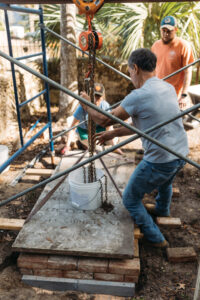
When you walk through a cemetery, history comes to life. And Palmetto Bluff’s archaeologists want to keep this history alive. In 2016, the archaeology team began restoring these cemeteries, in part to honor every person buried (marked or unmarked).
Archaeologists Dr. Mary Socci and Katie Epps manage the care and maintenance of these dozen cemeteries. And although the team completes the physical work in each cemetery, they spend more time researching and mapping in order to understand the connection between the land and the people buried at Palmetto Bluff. They maintain a map of each cemetery with a list of the headstones and footstones and the inscriptions for each stone. In the future, the archaeology team plans to use magnetometry to identify unmarked graves in the cemeteries. This noninvasive remote sensing technique detects differences in the magnetic properties of the soil. This critical work ensures current and future generations can honor those buried on Palmetto Bluff grounds.
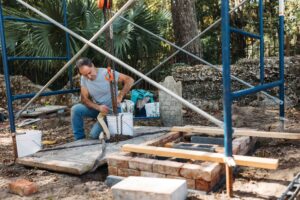
Each cemetery has a different challenge to tackle–some are on private land, some are overgrown, all have headstones that need attention. Palmetto Bluff Conservancy Land and Wildlife Manager Brian Byrne maintains right-of-way access to the cemeteries on private land for maintenance and restoration work. Initially, he removes dense or unsafe vegetation and then erects a cast-iron fence around the perimeter to outline the cemetery’s boundaries. Byrne maintains the monthly landscaping so the team can make additional restorations, such as attending to the headstones.
Socci and Epps work with cemetery restoration professionals to repair and reset headstones, repair box tombs, and even create new foundations for some monuments. Over time, the heavy stones often settle in the loose Lowcountry sand, bricks crack, and the original lime mortar erodes. A leaning monument is more likely to break, so resetting prevents future damage. Constructing foundations for horizontal headstones protects them from being covered or damaged. And they treat discolored stone with a safe, non-abrasive cleaner.
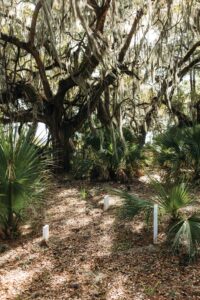
As the archeaology team completes the restoration process in one cemetery, they focus on restoring another. Six cemeteries are complete, two are in progress, and four will be restored in the coming years. Some particularly interesting repairs can be found in the Octagon Cemetery in the cottage area, the Screven-Hipp Cemetery by the Canoe Club pool, and the Landings Cemetery off Old Moreland Road.
Octagon Cemetery contains the graves of at least ten people. In January 2021, Frank Genello, a cemetery conservationist and owner of American Building Restoration Company, helped repair the almost 200-year-old box tomb of Dr. Samuel Fairchild, the owner of Octagon Plantation laid to rest in 1826. Genello and Palmetto Bluff’s archaeologists also constructed a three-course-high brick foundation for the horizontal headstone of Dr. Fairchild’s daughter Theresa Halsey Parkman’s children: Catherine Halsey Parkman (died 1829) and Samuel Fairchild Parkman (died 1819). It had been flush with the ground and was in danger of being stepped on or damaged from landscaping. The new unmortared brick foundation is easy to deconstruct if additional work is needed.
Montpelier Plantation’s Screven-Hipp Cemetery has two complete monuments and at least seven burials surrounded by the remains of a tabby wall. There are likely at least ten burials. One-time owner of the plantation, George Hipp’s stone is in excellent condition; however, until 2016, the monument for John and Elizabeth Screven and their four infant children was held together by wire. (The Screvens owned Montpelier prior to Hipp.) A cemetery restorer repaired the stone and set it on a new foundation. Paperwork detailing the work was left in a time capsule within the monument to ensure that future restorers know the methods and materials used.
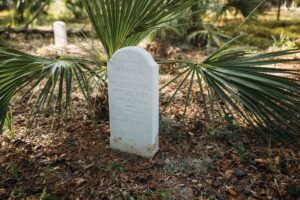
At Landings Cemetery, the various headstones and monuments commemorate seven people (three formerly enslaved people and four born after slavery). Often, the marked graves denote only a fraction of the people buried in the cemetery. Depressions mark the burials of those without permanent markers. The team cleaned and reset leaning headstones and footstones. In 2022, a prominent local businessman, Rollen Chalmers (see page 38), visited Palmetto Bluff to discuss rice production and his new business, Rollen’s RAW Grains. Chalmers, who grew up in Hardeeville, discovered that he had a connection to the land at Palmetto Bluff. His great-grandmother Maria Chalmers was buried at the Landings Cemetery.
Chalmers recalls, “When I visited the cemetery with Mary, Katie, and their team and saw the headstone of my great-grandmother, I was in disbelief! I’ve lived in Hardeeville all my life and did not know my great-grandparents were buried in Palmetto Bluff. After gathering myself and thinking about them being buried in this special cemetery, I felt that despite their circumstances, they were honored in their final resting place. Upon further research, Mary and her team discovered my great-grandfather, William Chalmers, leased land from Palmetto Bluff and grew and sold rice. I guess growing rice is in my blood.”
By conserving these cemeteries and researching those buried here, Palmetto Bluff’s archaeology team maintains a connection to the people who once called the Bluff home.
In front of the River House along the bank of the May River lies the Wilson Family’s dog cemetery. There are stones for Pixie, Winchester, Bess, Nip, Sam, Lady, Leo, Luke, and Tommy. All the dogs have concrete headstones except Tommy, whose marble headstone stands out. Tommy, a thirteen-year-old fox terrier, was Marion Wilson’s companion even before she married Richard T. Wilson.
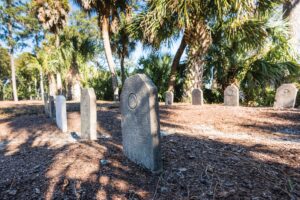
A graveyard is affiliated with a church and is typically located on church grounds, whereas a cemetery is neither.
Box Tombs are hollow, rectangular foundations that support horizontal headstones and mark the location of a body, which is buried approximately six feet below the ground surface.

Warm, fragrant, and deeply comforting, Chef Beth’s Southern Sausage & Sage Stuffing is a holiday classic that brings together rich pork sausage, fresh herbs, and toasted bread for the ultimate savory side dish. Studded with green apples and aromatic vegeta...
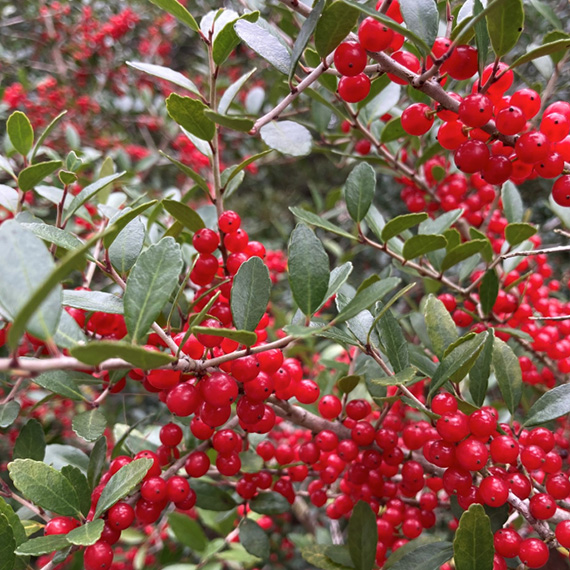
As December settles over Palmetto Bluff, it brings softer light, cooler mornings, and the natural beauty of native evergreens and winter berries that define the Lowcountry landscape. Palmetto Bluff Conservancy’s Education and Outreach Manager, Aaron Palmieri, ...

In 2025, Palmetto Bluff welcomed new neighbors and old friends, groundbreakings, and long-awaited openings. From inspired Club gatherings and elevated programming to the creation of our latest golf course, the year was defined by connection and excitement for ...
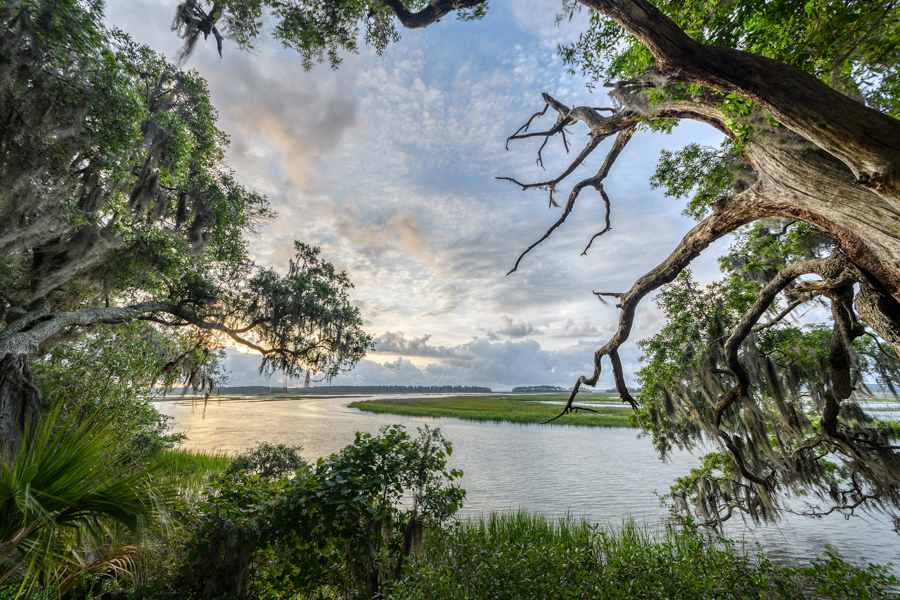
There is something serene about waking up to shimmering water, the stillness of the woods, or the sweep of marsh and sky right outside your window. Even without stepping outside, science shows that simply seeing nature from home can meaningfully improve mental...
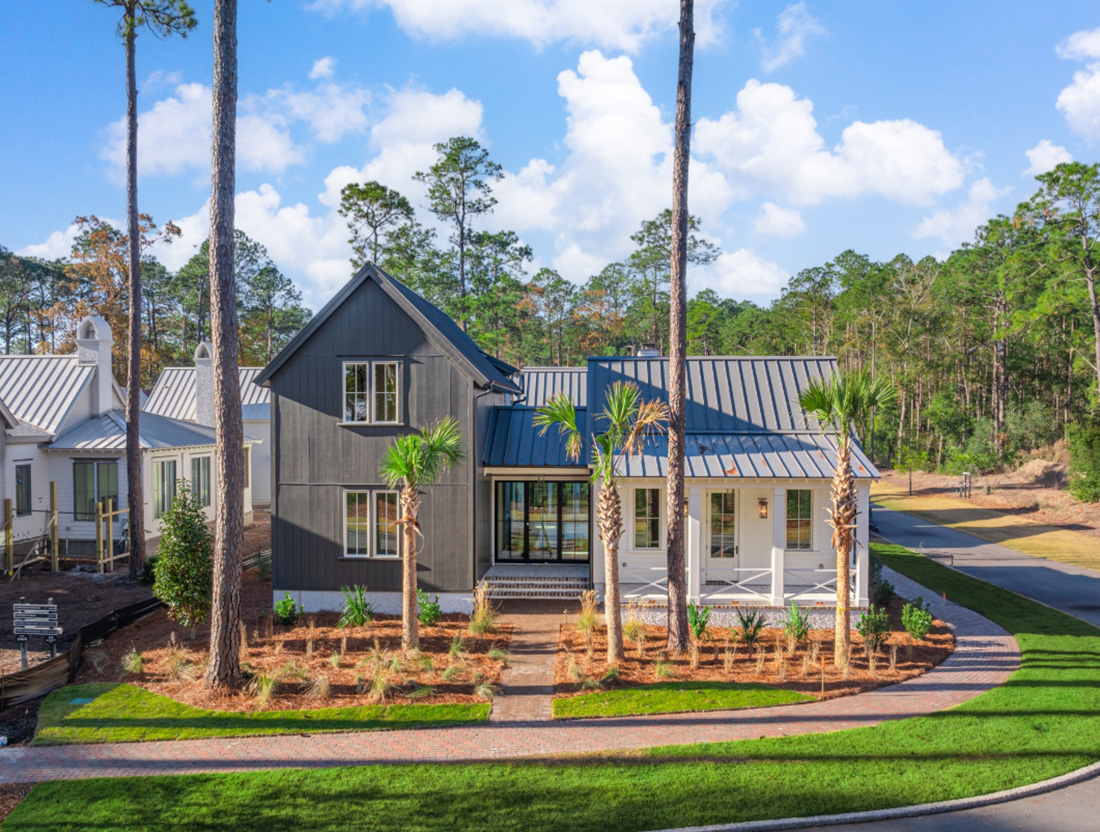
The Ultimate Choice: Building vs Buying a Home in Palmetto Bluff For those searching for Palmetto Bluff homes for sale, this common question often arises: Should you choose an existing residence, or embrace the opportunity to build your own? While a complet...
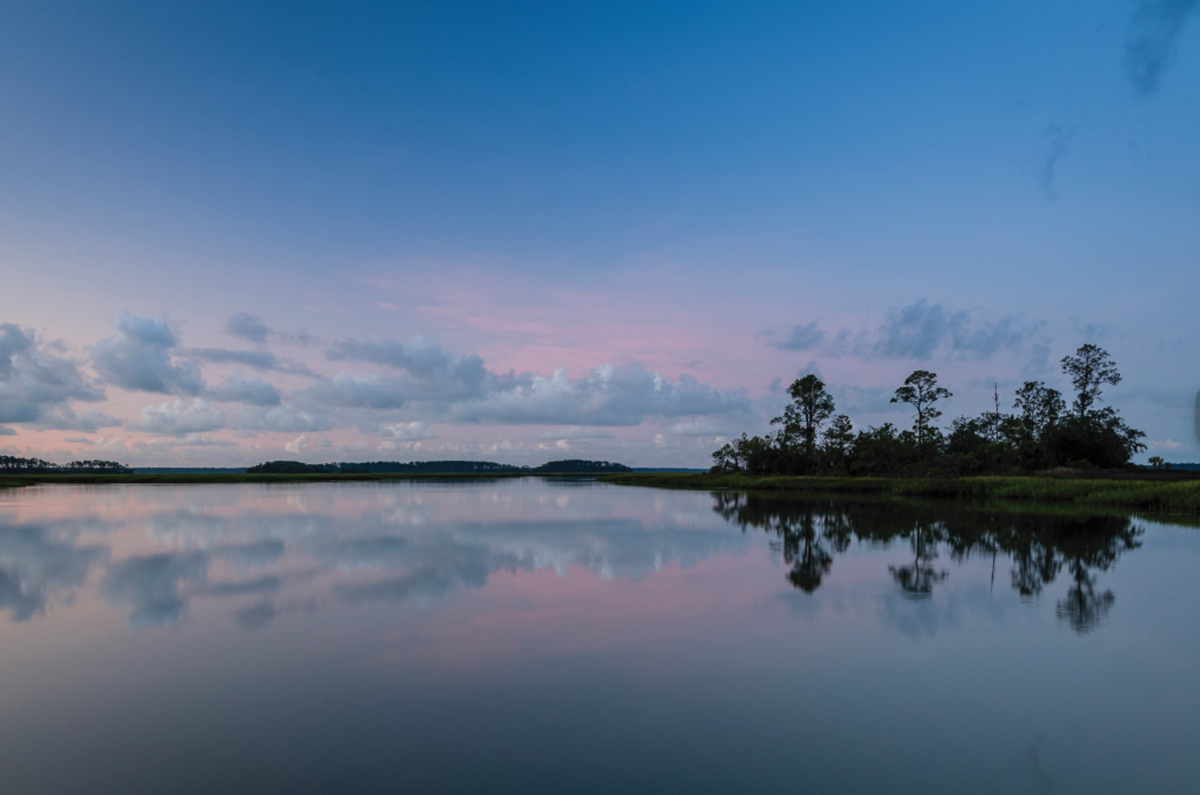
A Complete Guide to South Carolina Winter at Palmetto Bluff South Carolina's winter is unlike any other on the East Coast. While many travelers search for “South Carolina winter” expecting cooler temperatures and limited outdoor options, the Lowcountry revea...

River Road: Where Lowcountry Beauty Meets Elevated Everyday Living Tucked gracefully between Wilson Village and Moreland Village, River Road is one of Palmetto Bluff’s most immersive communities. It's where the pace of life seems to soften, classic Southern ...
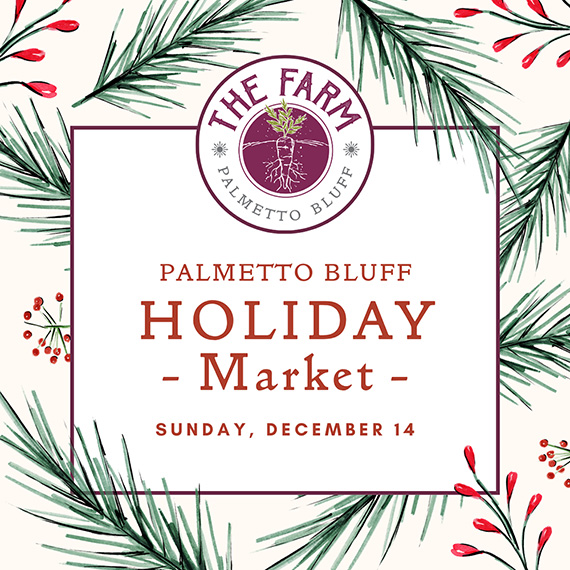
Sunday, December 14 | 9am to 1pmVillage GreenThe season’s most festive farmers market, the Holiday Farmers Market, comes to Wilson Village on Sunday, December 14, from 9am to 1pm. All are welcome to visit and experience the magic of holidays at the Bluff. The ...

Tucked amid whispering pines and overlooking a tranquil water trail, 11 Lyonia Street is where Lowcountry charm meets modern artistry. The newly built residence redefines Southern living with a balance of craftsmanship and calm. This is a home that feels both ...
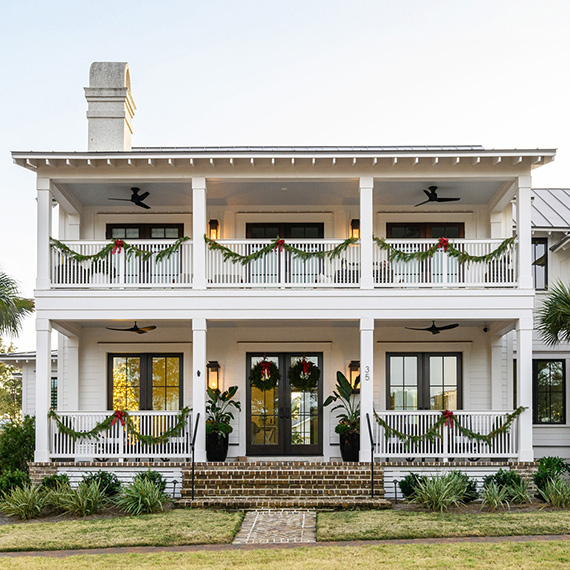
The holiday season in the Lowcountry brings crisp air, oaks draped in twinkling lights, and laughter drifting from homes where families and friends gather once again. At Palmetto Bluff, the holidays are more than just a season; they’re a feeling of togethernes...
We do not attempt to independently verify the currency, completeness, accuracy or authenticity of the data contained herein. All area measurements and calculations are approximate and should be independently verified. Data may be subject to transcription and transmission errors. Accordingly, the data is provided on an “as is” “as available” basis only and may not reflect all real estate activity in the market”. © [2023] REsides, Inc. All rights reserved. Certain information contained herein is derived from information, which is the licensed property of, and copyrighted by, REsides, Inc.